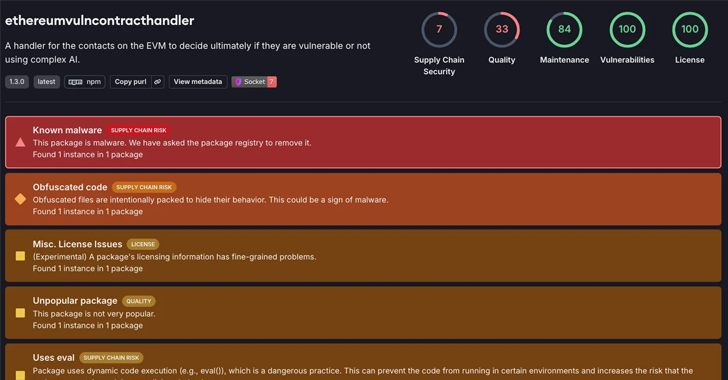Cybersecurity researchers have discovered a malicious package on the npm package registry that masquerades as a library for detecting vulnerabilities in Ethereum smart contracts but, in reality, drops an open-source remote access trojan called Quasar RAT onto developer systems.
The heavily obfuscated package, named ethereumvulncontracthandler, was published to npm on December 18, 2024, by a user Cybersecurity researchers have discovered a malicious package on the npm package registry that masquerades as a library for detecting vulnerabilities in Ethereum smart contracts but, in reality, drops an open-source remote access trojan called Quasar RAT onto developer systems.
The heavily obfuscated package, named ethereumvulncontracthandler, was published to npm on December 18, 2024, by a user
- From Phishing to Malware: AI Becomes Russia’s New Cyber Weapon in War on Ukraine The Hacker [email protected] (The Hacker News)
- Critical Exploit Lets Hackers Bypass Authentication in WordPress Service Finder Theme The Hacker [email protected] (The Hacker News)
- [Guest Diary] Building Better Defenses: RedTail Observations from a Honeypot, (Thu, Oct 9th) SANS Internet Storm Center, InfoCON: green
- ISC Stormcast For Thursday, October 9th, 2025 https://isc.sans.edu/podcastdetail/9648, (Thu, Oct 9th) SANS Internet Storm Center, InfoCON: green
- Vampire Bot Malware Sinks Fangs Into Job Hunters darkreadingJai Vijayan, Contributing Writer
- The Beginner’s Guide to Using AI: 5 Easy Ways to Get Started (Without Accidentally Summoning Skynet)by Tech Jacks
- Tips and Tricks to Enhance Your Incident Response Proceduresby Tech Jacks
- Building a Security Roadmap for Your Company: Strategic Precision for Modern Enterprises by Tech Jacks
- The Power of Policy: How Creating Strong Standard Operating Procedures Expedites Security Initiativesby Tech Jacks
- Building a Future-Proof SOC: Strategies for CISOs and Infosec Leaders by Tech Jacks
- Security Gate Keeping – Annoying – Unhelpfulby Tech Jacks
- The Beginner’s Guide to Using AI: 5 Easy Ways to Get Started (Without Accidentally Summoning Skynet)



Leave A Reply